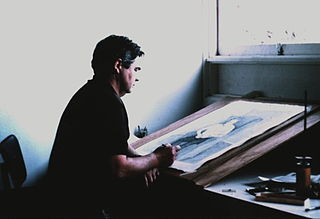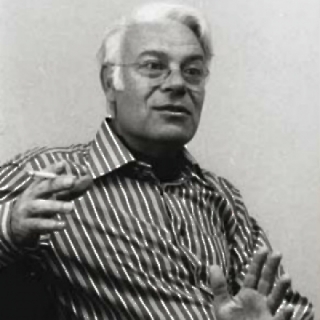The Djang'kawu, also spelt Djanggawul or Djan'kawu, are creation ancestors in the mythology of the Yolngu people of Arnhem Land in the Northern Territory of Australia. It is one of the most important stories in Aboriginal Australian mythology, and concerns the moiety known as Dhuwa.

John Brack was an Australian painter, and a member of the Antipodeans group. According to one critic, Brack's early works captured the idiosyncrasies of their time "more powerfully and succinctly than any Australian artist before or since. Brack forged the iconography of a decade on canvas as sharply as Barry Humphries did on stage."

Yirrkala is a small community in East Arnhem Region, Northern Territory of Australia, 18 kilometres (11 mi) south-east from the large mining town of Nhulunbuy, on the Gove Peninsula in Arnhem Land. It population comprises predominantly Aboriginal Australians of the Yolngu people, and it is also home to a number of Mission Aviation Fellowship pilots and engineers based in Arnhem Land providing air transport services.

Grahame Edwin King was a master Australian printmaker, who has been called the "patron saint of contemporary Australian printmaking". He was responsible for the revival of print making in Australia in the 1960s. He helped set up the Print Council of Australia, of which he was the first Honorary Secretary and was later President. He taught printmaking at The Royal Melbourne Institute of Technology (RMIT) from 1966 to 1988. In 1991, he was awarded an Order of Australia for his services to education. As well as teaching, King produced his own art work, concentrating on lithographs and monotypes. He was also a skilled photographer and used his photography both in his teaching and in his practice.
Wandjuk Djuwakan Marika OBE, was an Aboriginal Australian painter, actor, composer and Indigenous land rights activist. He was a member of the Rirratjingu clan of the Yolngu people of north-east Arnhem Land in the Northern Territory of Australia, and the son of Mawalan 1 Marika.
Gulumbu Yunupingu, after her death known as Djotarra or Ms Yunupingu, was an Australian Aboriginal artist and women's leader from the Yolngu people of Arnhem Land, in the Northern Territory of Australia.
Diane Mantzaris is an Australian artist known for her pioneering application of digital imaging to printmaking and for her unconventional approach to image making, which is often both personal and political in content. Mantzaris pioneered the use of computers as a printmaking and art-making tool in the early to mid-1980s, exhibiting widely, nationally and throughout Asia in touring exhibitions, to considerable acclaim. Her practice now crosses into several fields associated with the visual arts, printmaking, drawing, photography, sculpture, performance and public art. She is represented in most state and public collections throughout Australia and significant private collections throughout Asia and Europe.
Rona Green is an Australian visual artist.

Udo Sellbach (1927–2006) was a German-Australian visual artist and educator whose work focused primarily around his printmaking practice.
Banduk Mamburra Wananamba Marika was an artist and printmaker from Arnhem Land, Northern Territory, Australia. She was a member of the Rirratjingu clan of the Yolngu people, whose traditional land is Yalangbara. She was also an environmental activist and leader, and the first Aboriginal person to serve on the National Gallery of Australia's board.
Yvonne Boag is an Australian painter and printmaker whose work reflects the many places where she has lived and worked.
Alison Alder is an artist working predominantly within screen-printing media, technology-based works and "constructed environments" to explore social issues in Australia, including Indigenous Australian communities, and other organisations. She co-founded the Megalo International Silkscreen Collective with a collective of activists including Colin Little, the founder of earthworks Poster Collective, in 1980.
eX De Medici is an Australian artist, whose works include Installation art, painting, photography, and drawing. Her works often deal with concepts of power and violence, and recurring motifs include skulls, helmets, guns and the swastika symbol. She has exhibited widely across Australia and is included in the collections of the National Gallery of Australia (NGA), Canberra Museum and Gallery, Australian state galleries and in private collections. de Medici was an Artist Fellow at the CSIRO for more than a decade, was awarded a print making fellowship in 2006, and was an official war artist for The Regional Assistance Mission to Solomon Islands. She will be a featured artist in the NGA's major exhibition in 2020-2021, Know My Name, that will feature Australian women artists 1900 to today.
Dhuwarrwarr Marika, also known as Banuminy, a female contemporary Aboriginal artist. She is a Yolngu artist and community leader from East Arnhem Land in the Northern Territory of Australia. She belongs to the Dhuwa moiety of the Rirratjingu clan in the homeland of Yalangbara, daughter of Mawalan Marika. Marika is an active bark painter, carver, mat maker, and printmaker.
Mandy Martin was a well-known contemporary Australian painter, printmaker and teacher. She was involved in the development of feminist art in Australia from the mid-1970s and as exhibited widely in Australia and internationally. In later recent years she used the art she created as part of the ongoing debate on climate change, an area in which she was "prolifically active". Based in Canberra for many years, she was also a lecturer at the ANU School of Art from 1978 to 2003. As well as being a visual artist, Martin was an adjunct professor at the Fenner School of Environment and Society at the Australian National University.

Helen Elizabeth Ogilvie was a twentieth-century Australian artist and gallery director, cartoonist, painter, printmaker and craftworker, best known for her early linocuts and woodcuts, and her later oil paintings of vernacular colonial buildings.
Mawalan Marika, also referred to as Mawalan 2 Marika to distinguish from his grandfather Mawalan 1 Marika (c.1908-1967), is a Yolngu artist and land custodian of Arnhem Land in the Northern Territory of Australia. He is the son of well-known artist and leader Wandjuk Marika, and nephew to Banduk Marika.
Nancy Gaymala Yunupingu was a senior Yolngu artist and matriarch, who lived in Arnhem Land in the Northern Territory, Australia. She worked at the Buku-Larrnggay Mulka Centre in Yirrkala, where her work is still held, and is known for her graphic art style, bark paintings and printmaking.
Barbara Brash was a twentieth-century post-war Australian artist known for her painting and innovative printmaking. In an extensive career she contributed to the Melbourne Modernist art scene, beside other significant women artists including: Mary Macqueen, Dorothy Braund, Anne Marie Graham, Constance Stokes, Anne Montgomery (artist) and Nancy Grant.





